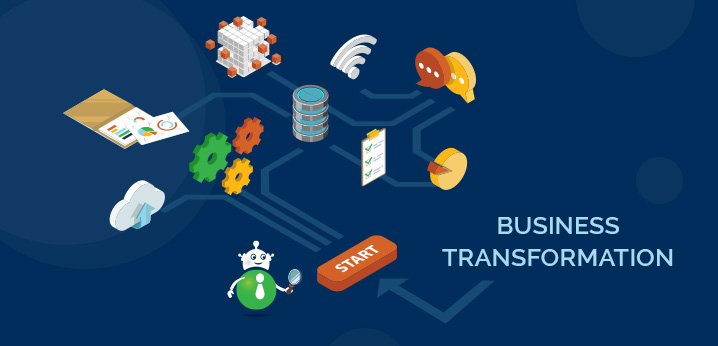
What Really Drives Successful Business Transformation?
SHARE THIS:
By Anil Konur, HuLoop Chief Customer Officer
Digital transformation—the concept is both daunting and exciting. Perhaps your company’s drive toward digital transformation has been part of an executive mandate to increase productivity and reduce growing labor costs. Or maybe you’ve been the executive sponsor toward a business transformation initiative designed to streamline and modernize your legacy technology infrastructure. Regardless of the origin, one thing is clear: a proper engagement model is necessary to drive successful business transformation outcomes.
Intelligent Automation = Business Transformation
In today’s environment, any successful digital transformation initiative must be accompanied by an investment in an intelligent automation platform. AI-powered, no-code intelligent automation platforms help organizations to drive significant impact without necessarily having to replace your current enterprise software platforms.
Intelligent Automation orchestrates business processes and tasks across, and in-between, disparate software platforms, organizational structures, documents, and data silos. It helps organizations to eliminate tasks and activities that don’t add value or no longer serve a purpose. It allows the automation of mundane, repetitive, and tedious tasks with digital workers or “bots.”
When done right, businesses can experience up to 60% improvement in productivity and up to 50% reduction in operational costs. As a result, intelligent automation platforms can simplify, accelerate and transform your business.
But for the implementation, and ultimately, adoption of intelligent automation to lead to business transformation, the organization needs to start by understanding their current readiness and automation maturity and select the best engagement model to meet their needs.
Start with an Internal Discovery and Alignment Workshop
Once an organization has decided to proceed with an Intelligent Automation platform to facilitate a business transformation initiative, the first step is to schedule a meeting with the various stakeholders to understand the organization’s business needs, expectations, culture, as well as executive team priorities. While rarely in conflict, executive and technology team priorities are not necessarily completely aligned, so it’s important for the automation provider’s facilitation team to ensure the needs of all stakeholders are captured and prioritized.
After the initial identification of goals, objectives, strategies, priorities and needs, it’s time to go deeper. This is the time when businesses need to understand where work is taking place at the individual, team, and department levels—and even enterprise-wide. This is critical for understanding an organization’s current business models (CBMs), and it provides the roadmap to successful digital transformation. The current business model is simply how the business currently performs certain processes/functions with existing technology and people.
There can be dozens or even hundreds of CBMs. It’s always best to prioritize and limit what to focus on at the beginning, and to avoid trying to do everything.
What You Will Likely Find
For most companies, tasks and activities within processes usually occur on enterprise software platforms such as SAP, Oracle, and Salesforce only 30% of the time. This means that up to 70% of a company’s task level work is done manually, on paper, via email, in Excel spreadsheets, or on internal communications systems like Teams or Slack.
Often the low hanging fruit associated with intelligent automation will be outside of or in between enterprise software applications. Without first identifying how their people, processes and technology are “really” interacting, organizations will be hard-pressed to illustrate their current state business model, let alone identify opportunities for business transformation.
Is There an Easier Way to Establish CBMs?
For companies that need help seeing, understanding, and changing the intersection of people, processes and technology, Data-Driven Process Discovery might prove to be a fast and easier way to capture current processes…and how work is really done today.
Data-Driven Process Discovery is a diagnostic capability where an Agent runs on the desktops of employees within a given organization or function. It automatically identifies, documents, and understands the interactions of people, processes, and technology over a time horizon. As data is collected, the tool interprets, and analyzes the intelligence, and it prescriptively identifies the best opportunities for transformation and automation based on return-on-investment.
Whether collected through discovery workshops or through Data-Driven Process Discovery, once a company understands the best automation opportunities that exist, it’s time to prioritize what to do short-term, medium-term, and long term.
Automation for Today – And Tomorrow
Every organization needs to assess their readiness and resources for Automation. Only the few, largest companies invest sufficiently in a dedicated “Center-of-Excellence” or “COE” which is a fully or partially dedicated team within the organization focused on driving or facilitating the various business transformation or automation activities. Most companies, especially small or medium-sized organizations, need help either from their software solution provider or a consulting services partner.
For this article, let’s focus on enterprises that need help. As an experienced service provider in this space, we have generally found three primary models that clients may use for their automation and transformation journey.
- Fast Start – Automation Factory – this approach ensures quick wins and allows for experimentation and learning. With a 30-60-90-day timeline, this is a relatively low stress approach designed to limit the effort of business and technology.
- Software-Enabled Business Transformation – this approach is a bit more structured and patient with a 3-6-9-month timeline, this approach involves more consulting and facilitation, as well as a higher commitment from the organization. The goal of this approach is true and meaningful business transformation. There is less focus on experimentation and more on making sure that the outcome is predictable and positive. This approach will require more commitment from the business and technology. It’s focused on promoting self-sufficiency, widespread adoption, and higher ROI.
- Automation-as-a-Service – with a 1-2-3-year timeline, this is a Center of Excellence talent augmentation approach which is applied across the enterprise and requires a strategic long-term commitment from the organization. This more complex implementation path utilizes dedicated, expert staff augmentation. In creating a business transformation Center of Excellence, support may be needed and provided onsite or offsite, onshore or offshore, with help creating and/or supplementing the implementation.
Resources needed for this level of initiative include:
- Engagement management
- Process owners
- Project management
- Business transformation consultants
- Software/quality engineers
- Change management
- End user support
Organizing the Project for Success
An effective engagement model is critical to the success of a business transformation initiative. It starts with understanding your current business models across the organization. Focusing on just enterprise software solutions to deliver transformative outcomes hasn’t been sufficient. In today’s environment, you simply can’t transform your business without embracing Intelligent Automation. Otherwise, you are taking a knife to a gun fight.
HuLoop Automation has an amazing array of Intelligent Automation capabilities. You should check out what our platform has to offer you. I think that you will be impressed! To learn more about the HuLoop Intelligent Automation Platform, please click here.
Beyond picking the right software, selecting the right engagement model for your organization’s business transformation maturity and appetite ensures immediate needs are prioritized, stakeholder buy-in is achieved, and employees are embracing the change. Ultimately, it’s about driving revenue growth, cost reductions, improved productivity, and better utilization of your human potential.
About the Author: Anil Konur
 With 20+ years of experience, Anil is a highly driven, team-oriented leader who is responsible for the success of all our customers from end to end. Anil brings a diverse background to the role in having led both technology and consulting teams. Anil is passionate about utilizing a collaborative, customer-centric approach in solving challenges and creating a culture of empowerment within his teams to drive successful outcomes in the most efficient way possible. Before HuLoop, Anil held various senior leadership roles at both startups and large organizations—including companies like Deloitte Consulting and Vision Service Provider (VSP).
With 20+ years of experience, Anil is a highly driven, team-oriented leader who is responsible for the success of all our customers from end to end. Anil brings a diverse background to the role in having led both technology and consulting teams. Anil is passionate about utilizing a collaborative, customer-centric approach in solving challenges and creating a culture of empowerment within his teams to drive successful outcomes in the most efficient way possible. Before HuLoop, Anil held various senior leadership roles at both startups and large organizations—including companies like Deloitte Consulting and Vision Service Provider (VSP).
About HuLoop Automation
Based in the Sacramento, California area, HuLoop Automation offers an AI-powered, no-code intelligent automation platform. This platform brings next generation hyperautomation innovation across a number of key solution areas: 1.) process and task discovery, 2.) business process automation (BPA), 3.) robotic process automation (RPA), 4.) intelligent document processing (IDP), 5.) software test automation (TA) and 6.) intelligent data automation (IDA). HuLoop is used across the enterprise by both businesspeople and technology experts. The platform delivers significant revenue growth, cost savings, and productivity gains across its prestigious customer base. Learn more at www.huloop.ai and follow HuLoop on LinkedIn, Facebook and Twitter.